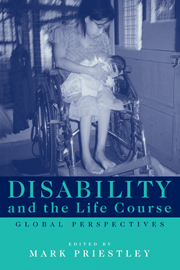Book contents
- Frontmatter
- Contents
- List of figures
- List of tables
- Notes on contributors
- Preface
- Acknowledgements
- A brief note on terminology
- I Concepts
- II Methods and stories
- 6 Life event histories and the US independent living movement
- 7 A journey of discovery
- 8 Using life story narratives to understand disability and identity in South Africa
- 9 Social change and self-empowerment: stories of disabled people in Russia
- 10 Lifting the Iron Curtain
- 11 Revisiting deaf transitions
- 12 The hidden injuries of ‘a slight limp’
- III The politics of transition
- Index
10 - Lifting the Iron Curtain
Published online by Cambridge University Press: 30 September 2009
- Frontmatter
- Contents
- List of figures
- List of tables
- Notes on contributors
- Preface
- Acknowledgements
- A brief note on terminology
- I Concepts
- II Methods and stories
- 6 Life event histories and the US independent living movement
- 7 A journey of discovery
- 8 Using life story narratives to understand disability and identity in South Africa
- 9 Social change and self-empowerment: stories of disabled people in Russia
- 10 Lifting the Iron Curtain
- 11 Revisiting deaf transitions
- 12 The hidden injuries of ‘a slight limp’
- III The politics of transition
- Index
Summary
I was born in September 1969 in Tallinn, the capital of Estonia and was immediately diagnosed as having a birth trauma. This diagnosis was soon formulated as cerebral palsy (some doctors have speculated that it might have been due to a rhesus conflict, others suspect the real cause to be carelessness by medical personnel). After the birth, the doctors did not leave my mother with much hope. At this time a young woman of 24, she was told that I would not live long and, at best, that I would remain a ‘vegetable’ for the rest of my life. Unofficially, she received a number of suggestions from the doctors (nowadays, perhaps best described as passive euthanasia). Many other disabled children have been, and continue to be, abandoned to the state at birth on the advice of doctors (see Human Rights Watch 1998).
The impact on my mother can only be imagined, particularly since I could have had an elder sister just three years earlier, who did not survive until birth. However, I decided to survive. Everyone except my parents dismissed my life in advance. Even many friends of the family shook their heads in disbelief. Faced with these circumstances, I can only assume that I owe my life to two really stubborn families, who came together to deny the critics and all those so-called realists.
- Type
- Chapter
- Information
- Disability and the Life CourseGlobal Perspectives, pp. 113 - 122Publisher: Cambridge University PressPrint publication year: 2001
- 3
- Cited by



